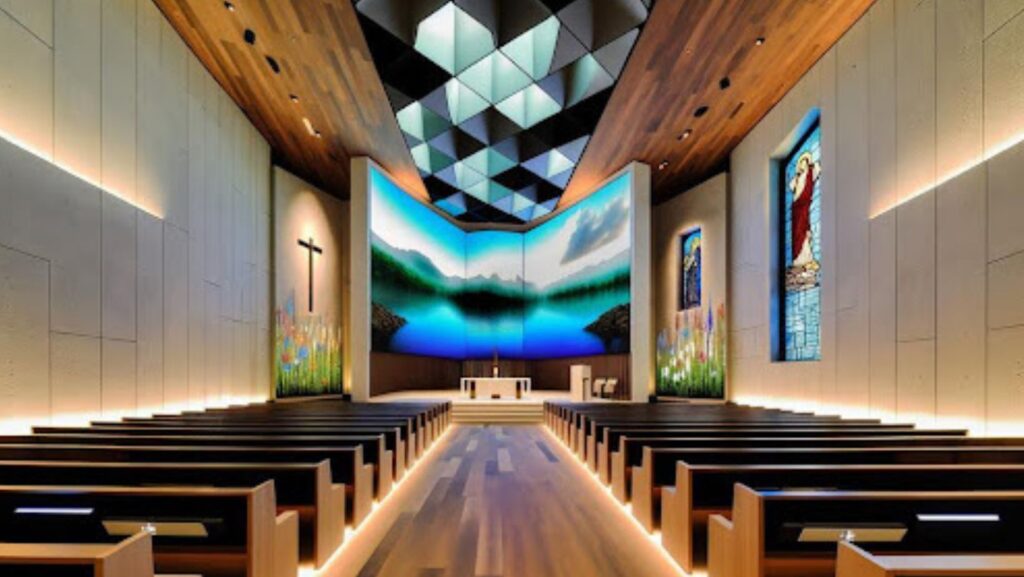Considering LED walls for your church can dramatically transform your worship experience, offering vibrant visuals and crystal-clear imagery that captivate the congregation. You’ll want to assess factors like display resolution, pixel pitch, and brightness to choose the right fit. But there’s more to it than just picking a screen—proper installation, budgeting, and ongoing maintenance are key to making this investment worthwhile. Imagine creating a dynamic worship space that deeply engages your congregation through powerful visual storytelling. So, how do you navigate these aspects to ensure a successful implementation?
Benefits of LED Walls
Church LED wall bring a plethora of advantages to churches, enhancing both the visual experience and the overall engagement of the congregation. The most significant benefit is their exceptional visual impact. LED walls offer high-resolution displays, ensuring that every detail, from text to intricate graphics, is crystal clear. This clarity helps in delivering messages more effectively and keeps the congregation’s attention riveted. The vivid colors and sharp contrasts create an immersive environment, making worship services and special events more engaging.
Another key advantage is energy efficiency. Unlike traditional projection systems, LED walls consume significantly less power. They utilize advanced energy-saving technologies, which translates to lower electricity bills and reduced environmental footprint. The long lifespan of LED panels also means fewer replacements and maintenance, making them a cost-effective solution over time.
Additionally, LED walls are versatile. They can be seamlessly integrated into any architectural design, offering flexibility in size and shape. This adaptability allows for creative layouts that can transform the ambiance of the worship space.
Choosing the Right LED Wall
Selecting the ideal LED wall for your church requires a careful assessment of key factors such as pixel pitch, brightness levels, and installation options. Begin by evaluating the display resolution, which directly affects image clarity and detail.
A lower pixel pitch, meaning the pixels are closer together, provides higher resolution, essential for detailed visuals and text readability, especially in large sanctuaries.
Next, consider the viewing distance. Calculate the average distance between the congregation and the LED wall. For closer viewing distances, a smaller pixel pitch (e.g., 1.5mm to 2.5mm) is necessary to avoid a pixelated appearance.
For larger venues where the audience is farther away, a larger pixel pitch (e.g., 3mm to 5mm) can still deliver crisp visuals without unnecessary cost.
Brightness levels are crucial. LED walls should have adjustable brightness to accommodate varying light conditions, ensuring visibility during daytime services and evening events.
Aim for an LED wall with a brightness level of at least 800 nits for indoor use, but consider higher levels if your church has abundant natural light.
Installation Requirements
To ensure a seamless installation, you’ll need to address several critical factors including structural support, power requirements, and data connectivity.
First, assess the structural integrity of the wall or framework where the LED panels will be mounted. The installation process demands that the surface can bear the weight of the LED modules and mounting hardware. You might need to reinforce the structure or add custom mounting solutions.
Next, consider the power requirements. Calculate the total wattage consumption of the LED wall and ensure that your electrical system can handle it. You may need to install dedicated circuits or upgrade your electrical infrastructure. Power redundancy is also a crucial aspect to consider to prevent disruptions during services.
Data connectivity is another vital component. You’ll need reliable and high-speed data transmission between the control system and the LED wall. Ensure proper cable management and consider using fiber optics for longer distances to avoid signal degradation.
Additionally, think about the cooling systems to manage heat dissipation, which is often overlooked but essential for maintaining optimal performance and longevity.
Budgeting for an LED Wall
Crafting a comprehensive budget for an LED wall involves not only the initial purchase price but also the long-term maintenance costs, installation expenses, and potential upgrades. To start, you’ll need a detailed cost estimation that includes the LED panels, control systems, mounting structures, and any necessary software. Factor in the cost per square foot of the LED wall, which can vary significantly based on resolution and brightness requirements.
When it comes to installation expenses, don’t overlook the labor costs for qualified technicians and potential structural modifications to your church. Additionally, you must incorporate electrical work, such as dedicated circuits and power supplies, into your financial planning.
Long-term maintenance is another critical component. Consider service contracts, potential repair costs, and periodic calibration to ensure optimal performance. It’s also wise to allocate a portion of your budget for future upgrades, as technology evolves and new features become available.
Effective financial planning will include a contingency fund to cover unexpected expenses that might arise during or after the installation. By accounting for these elements, you’ll ensure a smooth, financially sound implementation of your church’s LED wall, aligning with both your immediate needs and future growth.
Maintenance and Upkeep
Maintaining an LED wall in your church requires a proactive approach that includes regular inspections, cleaning routines, and timely software updates to ensure optimal performance and longevity.
Start with a bi-weekly cleaning schedule to prevent dust accumulation on the LED modules. Use anti-static brushes and lint-free cloths to gently clean the surface, avoiding harsh chemicals that could damage the diodes.
Inspect the LED wall monthly for any signs of wear, such as dead pixels or color inconsistencies. Early detection allows you to address issues before they escalate. Keep a stock of essential replacement parts, like LED modules and power supplies, to minimize downtime during repairs.
Regularly test the cooling fans and ensure they’re free from obstructions to maintain effective thermal management.
Software maintenance is equally crucial. Schedule quarterly updates for the LED wall’s control system to benefit from the latest features and security patches. Verify that firmware updates are compatible with your hardware configuration to avoid potential conflicts.
Enhancing Worship With LED Walls
Incorporating LED walls into worship services can dramatically elevate the visual and emotional impact of your church’s presentations. This leverages high-resolution displays and dynamic content to engage your congregation more effectively. Utilizing LED walls, you can transform sermons into compelling visual storytelling experiences. High-definition imagery and vivid colors captivate attention, making scriptural passages and thematic elements more relatable and memorable.
The key to achieving immersive experiences lies in the seamless integration of multimedia elements. Synchronize your LED wall with live video feeds, animated graphics, and synchronized lighting to create a cohesive worship environment. This integration not only enhances engagement but also fosters a deeper emotional connection with the congregation.
Moreover, LED walls provide unparalleled flexibility in content delivery. You can effortlessly switch between pre-recorded videos, live-streamed events, and real-time text displays. This adaptability ensures that your worship services remain dynamic and responsive to the needs of your congregation.
Conclusion
You’d think installing an LED wall in your church would be as simple as plugging in a TV. But no—choosing the right pixel pitch, ensuring correct brightness levels, and budgeting for hidden costs is just the beginning.
Ironically, it’s the maintenance that will test your faith. Yet, once everything’s in place, you’ll witness a worship experience so immersive, even the most devout congregants might think they’ve stepped into a divine cinema.
